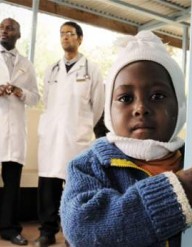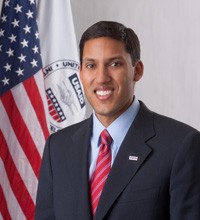Compared to 1990, today 4 million more children live past their fifth birthday every year because they have access to simple vaccines against diseases like measles and polio. Five million HIV patients no longer face a death sentence because they’ve been supplied with lifesaving antiretroviral drugs. And 188,000 more women survive the natural act of childbirth, thanks to the skilled attendants by their side.
Our ability to save these lives is a remarkable development success. But that same success has also established a system of care organized around diseases, not patients. Throughout the developing world, you’ll find separate clinics in separate places for AIDS, children’s health, family planning, and maternal care.
The Obama administration developed the Global Health Initiative to end this situation, providing different services at single points of care. In Kenya, we worked with PEPFAR, the President’s Emergency Plan for AIDS Relief, started by President George W. Bush, to couple HIV/AIDS treatment with maternal and child health services. As a result, we’ve extended the availability of reproductive health services from two to all eight of the country’s districts, at no increase in cost.
Every dollar we save through this approach is another dollar we can use to reach those who suffer. To put it simply: Saving money saves lives. But we can get even more value for our investments if we extend the reach of care beyond hospitals, into the villages and communities where people need it most.
In Senegal, we worked with the government to build “health huts,” small facilities in rural villages staffed by volunteers providing basic health services to their community. By building over 12,000 of these facilities throughout the country, we’ve managed to reach 400,000 more children at a much lower cost. No doctors, no hospitals—but access to quality, critical care for those who need it most.
In the future, our biggest opportunity to save lives in global health lies in inventing a new wave of medical technologies that are cheap, easy to use, and can be delivered anywhere. After all, a world-class vaccine doesn’t need to be administered in a world-class hospital for it to be effective.
A prime example of this type of breakthrough came last December, when a USAID-funded trial at a South African AIDS research lab gave women around the world a new way to reduce HIV transmission: a microbicide gel. Though still in development, women will eventually be able to use this gel to protect themselves against HIV.
If we can discover similar breakthroughs that can be delivered in health huts, not hospitals, we’ll have a remarkable opportunity to save lives.
If we can develop new, cheaper vaccines against pneumonia and diarrhea—the two leading causes of child death—we can save the lives of over 3 million children.
If we can devise a way to quickly diagnose malaria in the field, and come up with safer and more effective insecticides and drug treatments, we can save 500,000 lives and remove malaria as a major global health problem in sub-Saharan Africa.
And if we can create new technologies and procedures that allow a woman to give birth safely without a doctor by her side, we can save the lives of 200,000 mothers. We recently worked with other donors and foreign governments to unveil Saving Lives at Birth, a partnership designed to inspire inventors and entrepreneurs to solve this grand challenge for development.
Inventing these technological breakthroughs may sound audacious. But only by setting big goals can we inspire the innovation necessary to bend the curve of progress and meet them.










Comment
Make a general inquiry or suggest an improvement.